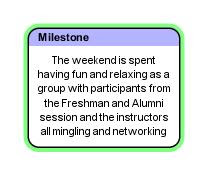So, I've already written several posts about the learning that went on in Cape Town this past September (see
here,
here and
here) and I guess it's time to move on. Still I want to leave you with a real taste for more and hopefully next time you'll come join us (see the
TOCICO calendar for upcoming events near you). This review did not include my sessions and I will share some of that material separately in a future time. It's on my list.
For this final post I chose to review 2 sessions that I found had a high impact on me:
I have already mentioned
Rami Goldratt's keynote on forecasting
here. He talks about the fact forecasting capabilities in retail are not improving. In fact, they are deteriorating. It is becoming harder and harder to generate predictions that will create good enough forecasts so as to lead to the right decisions. No one is expecting a forecast system to be able to predict accurately what will shop X sell next Tuesday. But the fact of the matter is these forecasts fail at much simpler questions such as how much of product Y will be sold by the entire network over the entire season. This is a simpler question as it is an aggregation, allowing for mistakes to average out.
Rami presented 3 major forces that are eroding the ability for forecast:
1 - Customers are increasingly requiring products to create the exact fit for their needs and tastes. As a result manufacturers and retailers increase their variety. Think of toothpaste, just as an example. It used to be that you were either a Crest user or a Colgate (or another brand). Now each brand has an extensive range of options - different tastes, different usages and problem resolution and many of the possible combinations of these. As the variety grows the volume per SKU shrinks and with it the ability to predict. At the same time the customers learn to expect even more accurate fit and it is clear there is a feedback loop making the situation grow more and more extreme.
 |
| Gateway Supermarket Sardines' Section (from Wikipedia) |
2 - Customer tolerance time is getting shorter, meaning retailers lose more sales when the exact inventory is not on hand. For example, in a market research Rami cited, people stated that they will pay a higher premium for immediacy that for technological improvement. As a result there is pressure to hold more inventory at the point of sales.
3 - The product life cycle is getting shorter. Customers are forever expecting new products and so there is a on going pressure on NPIs. New products do not have a history we can use for predictions and they have a major impact on the sales of current products (that have a high level of inventory in the shops from item#2) thus practically eliminating the ability to forecast.
On top of all this (as if that was not enough) more and more industries suffer from a product life cycle that is shorter than the supply time.
With all these phenomenas increasing over time, relying on forecasts will lead companies to fail. What we need is a system to minimize the time needed for reading and understanding the signals from the shop floor and to react to them fast. We have the needed IT, we are just using it the wrong way.
Just so you know, Rami promised a video covering all this in more detail - Rami, we are waiting.
The second talk was by
Dr. Alan Barnard concentrating on flow. Re-reading Dr. Goldratt's "
Standing on the Shoulders of Giants", Alan pointed out that the
5 Focusing Steps are actually an application and should only be used when the boundary conditions dim them relevant. Instead he suggest starting with the concept and principals of flow:
1 - The prime objective of operations is to focus on flow, specifically on reducing flow time.
2 - This objective is to be translated into a practical mechanism that guides operations when not to produce.
3 - Local efficiencies must be abolished.
4 - A focusing process to balance flow must be in place.
The application of these principals will be:
1- Separate work and time buffer.
2 - Aggregate time buffers.
3 - Remove unnecessary buffers
4 - Simplify flow with a single time buffer.
Looking over these lists it is clear that the 5 Focusing Steps, which are used for constraint or bottleneck management, are only relevant when those are the primary causes of blocks to the flow.
This is just the tip of the iceberg, of course. I highly recommend getting access to the conference videos for these sessions, if you weren't there.
If you enjoyed this and want to learn more - share it and subscribe to this blog, great things are coming.


















